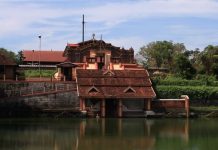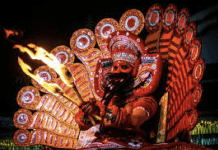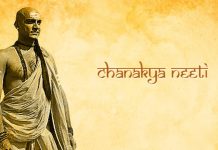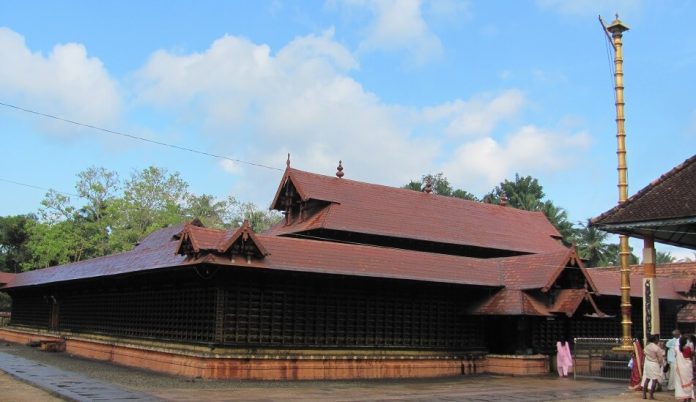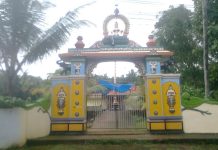Dedicated to the beloved Lord Krishna (Sri Krishna), the Evoor Major Sri Krishnaswamy Temple stands as an ancient sanctuary nestled amidst the serene landscapes of Evoor, near Haripad in Kerala, India. This ancient temple is not just a religious landmark but a repository of mythological tales, architectural beauty, and the spirit of devotion. With its roots tracing back to the Mahabharata era, this temple has endured centuries, carrying with it a rich tapestry of stories and traditions.
Legend and History:
The genesis of the Evoor Major Sri Krishnaswamy Temple is intricately woven with the epic Mahabharata and the tale of Khandava-dahanam, the burning of the Khandava forest. This legend unfurls the temple’s origins, as Lord Agni, the deity of fire, sought a remedy for his chronic stomach ailment. Instructed by Lord Brahma, he aimed to consume the herb-rich Khandava Forest. However, the forest was not without its protectors, including Takshaka, the Serpent King, and Lord Indra, who thwarted Agni’s efforts with thunderous rains.
Agni’s plea for assistance reached the ears of Lord Krishna and the valiant Arjuna, who came to his aid. With Lord Krishna’s divine guidance, they set out to fulfill Agni’s mission. Amidst this, Kanva Maharshi, one of the Saptarshis, arrived to save his Arca Murty, a four-armed image of Mahavishnu, from the impending fire. Lord Krishna, in his benevolence, granted a boon to Kanva that the Murty would be saved from the fire’s fury.
As the Khandava forest was devoured by Agni, Arjuna constructed a “Sharakoodam” or a shelter of arrows, following Lord Krishna’s instructions. The forest’s destruction was complete, Agni’s ailment was cured, and as a gesture of gratitude, Agni sought permission to install the Murty in a new temple. Arjuna, under Lord Krishna’s guidance, found the spot where an arrow landed and consecrated the temple. Alongside the main deity, Bhoothanathaswamy in his ‘Kiratha Murthy’ form and Yakshi Amma (Devi Parvathy) were consecrated as sub-deities.
However, the temple faced adversity about 125 years ago when fire engulfed its sanctum sanctorum. Despite efforts to remove the deity, it remained unscathed. It was at this juncture that King Moolam Thirunal, after receiving a divine dream in Kasi, embarked on a mission to reconstruct the temple. Upon his return, he rebuilt the temple, enhancing its infrastructure with security trenches on the roof and an underground drainage network for ‘abhisheka water.’
Festivals:
The Evoor Major Sri Krishnaswamy Temple comes alive during its annual festival, “Makara Ulsava.” Starting with the auspicious hosting of the Garuda flag, this festival culminates with the sacred “Aaaraattu” or Holy Bath. It’s a time when the town comes alive with a festive spirit, as streets are adorned with arches, festoons, and decorations. Every building is aglow with the warm light of traditional lamps, plantain trunks, and bunches of coconuts. The first five days are jointly sponsored by the Travancore Devaswom Board and specific devotee groups. Days 7, 8, and 9 are managed by three ‘Karas’ or villages – Evoor South, Evoor North, and Evoor North-West – who infuse their unique charm into the festivities. Cultural expressions abound with processions, traditional music, illuminations, and spectacular fireworks. The festival culminates with a series of rituals that leave a spiritual imprint on all who partake.
Other Festivals Associated with Evoor Temple:
Vishu Ulsavam – Welcoming the New Year: Vishu Ulsavam, celebrated during the Malayalam New Year (Vishu), marks a time of renewal and fresh beginnings. Devotees throng to the temple to seek Lord Krishna’s blessings for a prosperous year ahead. Special pujas, processions, and cultural performances add a festive charm to this occasion.
Aiyalyam Makam: This festival, dedicated to Lord Krishna, is celebrated with great devotion and cultural fervor. It involves traditional pujas, processions, and offerings to the deity.
Shankaranthi Vallam Kali: Shankaranthi Vallam Kali is a traditional boat race that takes place in the temple pond. Teams compete with beautifully decorated boats, showcasing the region’s rich maritime heritage.
Tiruvonam Ulsavam: Tiruvonam Ulsavam is a festival dedicated to Lord Krishna and is celebrated with great enthusiasm. Devotees come together to participate in various rituals and cultural events.
Ashtami Rohini – Krishna’s Birthday: Ashtami Rohini is a significant festival at the Evoor Major Sri Krishnaswamy Temple, celebrating the birth of Lord Krishna. Devotees gather to mark this auspicious occasion with special pujas, bhajans, and cultural performances.
Kuchela Dinam: This festival commemorates the divine friendship between Lord Krishna and Kuchela (Sudama). Devotees offer prayers and seek the blessings of the Lord on this special day.
Temple Timings:
The Evoor Major Sri Krishnaswamy Temple is open for devotees from 5:00 AM to 12:00 PM in the morning and from 5:00 PM to 8:00 PM in the evening.
How to Reach Evoor Major Sri Krishnaswamy Temple
By Air:
The nearest airport to Evoor Major Sri Krishnaswamy Temple is Trivandrum International Airport (Thiruvananthapuram), which is approximately 100 kilometers away. From the airport, you can hire a taxi or take a bus to reach the temple.
By Rail:
Evoor Temple is conveniently accessible by train. It is situated near the Cheppad Railway Station, which is on the coastal railway route between Kayamkulam and Harippad. Travelers can take a train to Cheppad Junction and then proceed to the temple by auto-rickshaw.
By Road:
For those traveling by road, the temple is located on NH-47, making it easily accessible by both private and public transportation. The nearest bus stations are Kayamkulam, which is approximately 7 kilometers to the north, and Harippad, around 5 kilometers to the south. You can reach Evoor Temple by taking a bus to the Evoor Temple bus stop, which is south of Cheppad and north of Ramapuram Devi temple, and then walk approximately 1 kilometer east to reach the temple premises.



